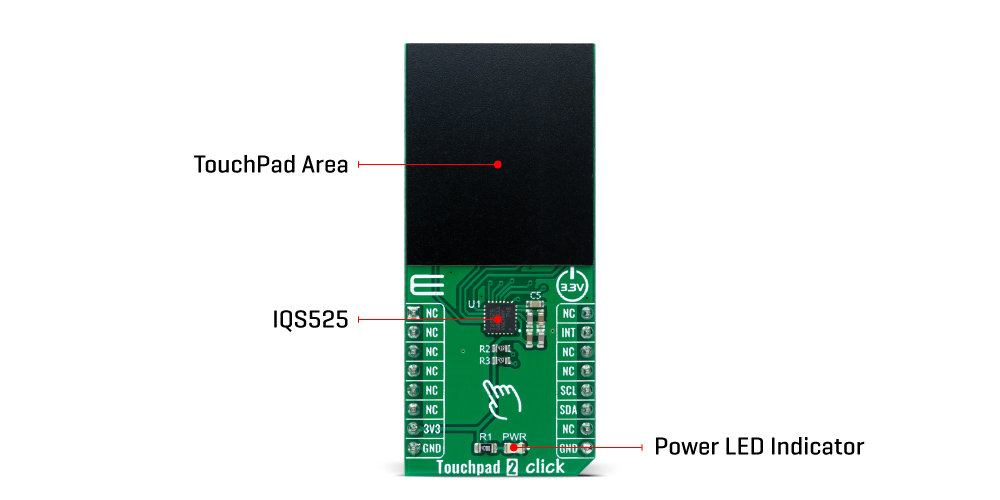






Overview
The TouchPad 2 Click Board™ is a compact add-on board that easily integrates projected capacitive touch into their applications. This board features the IQS525, a projected capacitive touch and proximity trackpad/touchscreen controller from Azoteq. It features best-in-class sensitivity, signal-to-noise ratio, and automatic tuning of electrodes, in addition to the multi-touch and multi-hover features. This Click Board™ is characterized by embedded gesture engine recognition for simple gestures (tap, swipes, hold) and built-in noise detection and filtering. This Click Board™ is suitable for human-machine interfaces, keypad or scrolling functions, single-finger gesture-based interfaces, and more.
The TouchPad 2 Click Board™ is supported by a mikroSDK compliant library, which includes functions that simplify software development. This Click Board™ comes as a thoroughly tested product, ready to be used on a system equipped with the mikroBUS™ socket.
Downloads
How Does The Touchpad 2 Click Board™ Work?
The Touchpad 2 Click Board™ as its foundation uses the IQS525, a capacitive sensing controller designed for multitouch application using projected capacitance touch panel from Azoteq. It offers high sensitivity proximity/hover detection and contact (touch) detection. The device has an internal voltage regulator and Internal Capacitor Implementation (ICI) to reduce external components, which can be noticed on the Click board™ (very few additional components required by this IC). Advanced integrated signal processing capabilities yield a stable, high-performance capacitive controller with high sensitivity.

On the front side of the Touchpad 2 Click, there is a clearly defined field that represents a touchpad area. This area is a matrix of conductive electrodes on the PCB, electrically isolated from each other, arranged as rows and columns of X and Y. An electrode consists of multiple diamond-shaped elements, each connected to the next with a conductive neck.
The controller uses the principle of projected capacitance charge transfer on the touchpad area. When a conductive object such as a human finger approaches the sense plate, it will decrease the detected capacitance. Observing the measured results at various sensing points on the touchpad area enables the controller to determine proximity/hover detection and contact (touch) detection on all channels and accurately determine the coordinates on the touch area.
Due to the advanced sensitivity of the IQS525, multiple non-contact (proximity hover) coordinates also can be obtained. These hover coordinates can predict the touch coordinate of an approaching user before the touch is made, allowing innovative user interface options. Multiple filters are implemented to suppress, detect noise, and track slow varying environmental conditions and avoid effects of possible drift.
The Touchpad 2 Click Board™ communicates with MCU using a standard I2C 2-Wire interface, with a clock frequency up to 100kHz in the Standard and 400kHz in the Fast Mode. An additional ready signal, routed on the INT pin of the mikroBUS™ socket, is added, which indicates when the communication window is available. Thus, it is optimal for the response rate to use the INT pin as a communication trigger, but polling is also a less attractive option.
ThTouchpad 2 Click Board™ can be operated only with a 3.3V logic voltage level. The board must perform appropriate logic voltage level conversion before use with MCUs with different logic levels. However, the Click board™ comes equipped with a library containing functions and an example code that can be used, as a reference, for further development.
SPECIFICATIONS
| Type | Capacitive |
| Applications | Can be used for human-machine interfaces, keypad or scrolling functions, single-finger gesture-based interfaces, and more. |
| On-board modules | IQS525 - capacitive sensing controller designed for multitouch application using projected capacitance touch panel from Azoteq |
| Key Features | Multi-touch and multi-hover support, automatic drift compensation, embedded gesture engine recognition for simple gestures (tap, swipes, hold), and more. |
| Interface | I2C |
| Compatibility | mikroBUS |
| Click board size | L (57.15 x 25.4 mm) |
| Input Voltage | 3.3V |
PINOUT DIAGRAM
This table shows how the pinout of the Touchpad 2 Click Board™ corresponds to the pinout on the mikroBUS™ socket (the latter shown in the two middle columns).
| Notes | Pin |  |
Pin | Notes | |||
|---|---|---|---|---|---|---|---|
| NC | 1 | AN | PWM | 16 | NC | ||
| NC | 2 | RST | INT | 15 | INT | Interrupt | |
| NC | 3 | CS | RX | 14 | NC | ||
| NC | 4 | SCK | TX | 13 | NC | ||
| NC | 5 | MISO | SCL | 12 | SCL | I2C Clock | |
| NC | 6 | MOSI | SDA | 11 | SDA | I2C Data | |
| Power Supply | 3.3V | 7 | 3.3V | 5V | 10 | NC | |
| Ground | GND | 8 | GND | GND | 9 | GND | Ground |
ONBOARD SETTINGS AND INDICATORS
| Label | Name | Default | Description |
|---|---|---|---|
| LD1 | PWR | - | Power LED Indicator |
TOUCHPAD 2 CLICK ELECTRICAL SPECIFICATIONS
| Description | Min | Typ | Max | Unit |
|---|---|---|---|---|
| Receiver inputs voltage range | - | 3.3 | - | V |
| Receiver inputs voltage range | - | 16 | - | bit |
| Receiver inputs voltage range | -40 | +25 | +85 | °C |
| General Information | |
|---|---|
Part Number (SKU) |
MIKROE-4594
|
Manufacturer |
|
| Physical and Mechanical | |
Weight |
0.02 kg
|
| Other | |
Country of Origin |
|
HS Code Customs Tariff code
|
|
EAN |
8606027382512
|
Warranty |
|
Frequently Asked Questions
Have a Question?
Be the first to ask a question about this.







